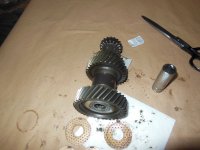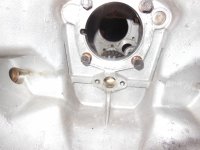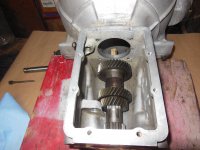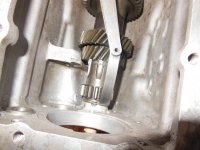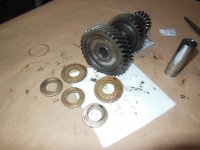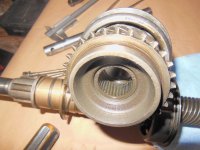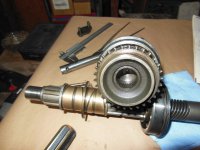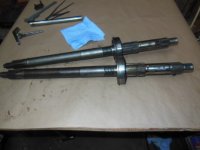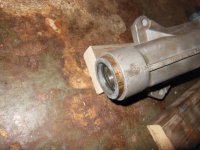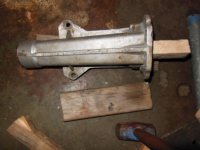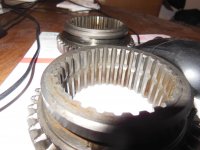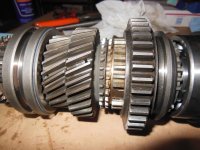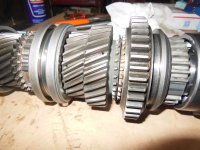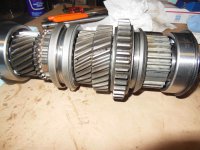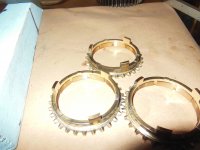Sorry John I was not very clear about the question of the tapper. I am not sure I knew exactly how to ask the question because I had not evaluated all the information or saw where all the surfaces met, yet. I see now the area in question is the areas in the center of the big constant mesh gear which gets hidden behind the thrust-washer; it all gets hide when the trust-washer is installed. I did not realize the thrust washer does not rub the entire end of the shaft. The washer has those oil passed ways
I put the large thrust washer onto the case over its hole with some grease to hold it in place. The needle bearings and end caps went back inside the lay shaft with some grease and everything went well.
Next after reading some, I decided to use a ¾ inch dummy rod the exact length of the shaft to hold the needle bearings in place. I set the cluster gears in the bottom of the case. Then I thought I need to get the end float measurement, so I cut another ¾ wood rod; this time I cut the wood rod bigger probably about a foot longer, so the rod would stick out both ends of the transmission case as I push the shorter dummy rod out.
This way the lay-shaft would be sitting were it goes, and I have both hands free to measure the end float. I pick through the washers I had and dropped the one I liked best straight down as I wiggled the rod from the bellhousing end and dropped the thrust-washer in place right when rod passed through giving me about ¼ inch of room to fit the thrust-washer.
I could get a 0.08 feller gauge between the thrust-washer and the shaft, but could not get the 0.008 installed at the distance piece on the shaft. I pulled the feller gauge out the back and wiggle the shaft and the end float looks and sounds about right. The shaft spins nice. I am good, I think.
Now I will push the longer rod out and place the short rod in and drop the cluster set down to the bottom of the case, so I can get the main shaft going. Then mesh the main and the lay shaft when center bearing goes into its hole.
Roy, thanks for the articles. Second gear has always been a problem for me and I am going to replace the balls and springs.
steve
I put the large thrust washer onto the case over its hole with some grease to hold it in place. The needle bearings and end caps went back inside the lay shaft with some grease and everything went well.
Next after reading some, I decided to use a ¾ inch dummy rod the exact length of the shaft to hold the needle bearings in place. I set the cluster gears in the bottom of the case. Then I thought I need to get the end float measurement, so I cut another ¾ wood rod; this time I cut the wood rod bigger probably about a foot longer, so the rod would stick out both ends of the transmission case as I push the shorter dummy rod out.
This way the lay-shaft would be sitting were it goes, and I have both hands free to measure the end float. I pick through the washers I had and dropped the one I liked best straight down as I wiggled the rod from the bellhousing end and dropped the thrust-washer in place right when rod passed through giving me about ¼ inch of room to fit the thrust-washer.
I could get a 0.08 feller gauge between the thrust-washer and the shaft, but could not get the 0.008 installed at the distance piece on the shaft. I pulled the feller gauge out the back and wiggle the shaft and the end float looks and sounds about right. The shaft spins nice. I am good, I think.
Now I will push the longer rod out and place the short rod in and drop the cluster set down to the bottom of the case, so I can get the main shaft going. Then mesh the main and the lay shaft when center bearing goes into its hole.
Roy, thanks for the articles. Second gear has always been a problem for me and I am going to replace the balls and springs.
steve

 Hi Guest!
Hi Guest!

 smilie in place of the real @
smilie in place of the real @
 Pretty Please - add it to our Events forum(s) and add to the calendar! >>
Pretty Please - add it to our Events forum(s) and add to the calendar! >> 
